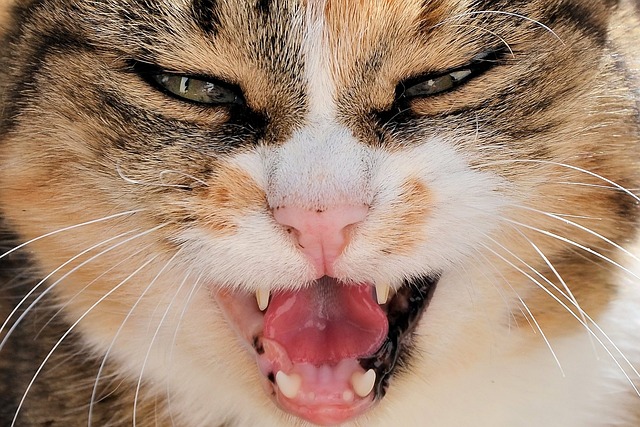Introduction
Aggressive behavior in cats is a topic that often concerns pet owners, veterinarians, and animal behaviorists alike. This behavior manifests in various forms, such as hissing, growling, scratching, or biting, and can be distressing for both the cat and its human companions. It’s essential to understand that aggression is often a form of communication for felines, a way for them to express discomfort, fear, or territorial claims. While it’s a natural behavior, it’s not one that should be overlooked, especially if it poses a risk to people or other animals in the household.
The significance of managing aggressive behavior lies not just in safeguarding human and animal members of the home but also in improving the quality of life for the aggressive cat. Aggressive behavior can be symptomatic of underlying issues—medical, behavioral, or environmental—that require attention. Leaving aggressive behavior unaddressed can lead to escalating stress and tension, affecting the overall well-being of your pet. Remember, a calm and happy cat is generally a healthy cat, and if aggressive tendencies are displayed, it’s often a cry for help in some form.
In this comprehensive guide, we will delve deep into the intricacies of feline aggression. We will start by identifying various signs that indicate aggressive behavior, focusing on vocalizations like hissing and growling, as well as specific body language cues such as an arched back or flattened ears. The different types of aggression, including defensive, offensive, and redirected aggression, will also be discussed to help you accurately diagnose the issue at hand.
Next, we’ll explore the underlying causes of such behaviors. Is it medical, behavioral, or environmental? Pinpointing the root cause is critical to finding a successful resolution. You’ll learn about immediate steps to manage sudden bouts of aggression and long-term solutions for persistent issues. From veterinary consultations and behavioral modification techniques to environmental changes and potential medication—this article aims to be your one-stop guide for understanding and managing aggressive behavior in cats effectively.
So, whether you’re a first-time cat owner puzzled by your feline’s sudden bouts of aggression, or a seasoned pet parent looking for advanced behavioral insights, this article aims to equip you with the knowledge and tools you need to create a peaceful co-existence with your feline friend.
In the following sections, we’ll arm you with a host of practical tips, expert opinions, and science-backed methods designed to turn your hissing, scratching furball into the purring, cuddly companion you love and adore. Let’s get started on this journey towards understanding and resolving feline aggression.
Identifying Signs of Aggressive Behavior
Hissing, Growling, Scratching, and Biting
Hissing and growling are vocal indicators of discomfort or threat in cats. These noises are often a cat’s last warning signal before resorting to physical aggression like scratching or biting. It’s important to take these vocalizations seriously and not to dismiss them as mere ‘bad moods.’ If your cat is hissing or growling, it’s likely feeling threatened or annoyed and is communicating its need for space or a change in circumstances.
Body Language: Arched Back, Raised Fur, Flattened Ears
An arched back and raised fur are classic signs of a cat preparing for a confrontation. In the animal world, making oneself appear larger is a common defensive tactic. A cat that is arching its back and puffing up its fur is likely feeling threatened and is trying to ward off a perceived threat. Flattened ears also indicate stress or aggression; this posture serves to protect the ears in a fight and is a clear signal that the cat is not in a playful or relaxed mood.

Types of Aggression: Defensive, Offensive, and Redirected Aggression
Understanding the type of aggression your cat is displaying can provide valuable insights into its underlying cause. Defensive aggression occurs when a cat feels cornered or threatened. Offensive aggression, on the other hand, happens when a cat takes an active approach to assert its dominance or territorial rights. Redirected aggression is a bit more complex; this occurs when a cat, agitated by one stimulus (like a stray cat outside), attacks a neutral party, often its owner or another pet. Each type of aggression requires a different approach for management and resolution.
By recognizing these key signs and types of aggressive behavior in cats, you are better equipped to take immediate action. This will not only protect you and others from harm but also address the underlying issues causing your pet’s discomfort. This knowledge is the first crucial step in effectively managing and ultimately resolving aggressive behavior in your cat.
Understanding the Causes of Aggressive Behavior

Medical Issues
Aggressive behavior in cats can sometimes stem from underlying medical issues. Pain or discomfort, hormonal imbalances, or illnesses affecting mood and cognition can all trigger aggression. A sudden onset of aggressive behavior with no apparent reason should prompt a veterinary evaluation to rule out medical causes.
Behavioral Causes
Behavioral factors can also play a role in feline aggression. Territorial disputes, social dynamics with other cats, or fear-based reactions are common behavioral triggers. Understanding these can help you address the aggression at its root, whether it’s modifying the environment or consulting a behavior specialist.
Environmental Factors
Your cat’s environment can significantly influence its mood and behavior. Overstimulation, or exposure to stressors like loud noises, new people, or changes in routine can lead to aggressive actions. Sometimes a simple environmental modification, like creating a safe space or quiet corner, can significantly reduce stress-induced aggression.
By gaining a deeper understanding of the possible causes of your cat’s aggressive behavior, you set the stage for more targeted and effective solutions. Each cause necessitates a unique approach to management, making identification crucial for long-term success. This section serves as a foundation for the actionable steps we’ll explore in the subsequent parts of this guide.
Environmental Changes
Creating Safe Spaces for the Cat
One effective strategy for managing aggression is to create a designated “safe space” for your cat. This could be a specific room or a cozy corner equipped with a bed, toys, and scratching post. A safe space serves as a retreat for your cat, helping to mitigate stress and lower aggression levels.
Enrichment: Toys and Activities to Channel Energy
Toys and activities can also play a crucial role in managing aggression. Interactive toys, puzzle feeders, and regular play sessions can help channel your cat’s energy constructively, reducing instances of aggressive outbursts. Enrichment activities provide mental and physical stimulation, which can alleviate boredom-induced aggression.
The Importance of Routine

Cats are creatures of habit and thrive on routine. Consistent feeding times, play sessions, and sleep schedules can significantly influence a cat’s behavior. A well-structured routine can offer a sense of security and predictability, reducing stress and, consequently, aggressive tendencies.
By implementing these environmental changes, you’re not just addressing the symptoms of aggression but also its underlying causes. Small changes in a cat’s surroundings can lead to significant shifts in behavior, turning a tense, aggressive feline into a more relaxed and content companion.
Medication

The Role of Medication in Managing Aggression
Medication should generally be considered a last resort after other methods have failed to manage aggression. Pharmaceuticals can act as a temporary measure to reduce aggressive tendencies, thereby allowing time for long-term solutions to take effect. Always consult a veterinarian before administering any medication to your cat for behavioral issues.
Commonly Prescribed Medications
Some medications like fluoxetine (Prozac), clomipramine, or gabapentin are occasionally prescribed for aggressive cats. These medications work by altering neurotransmitter levels in the brain, which can result in reduced aggressive behaviors. However, they should only be used under veterinary supervision.
Potential Side Effects
While medication can be effective in reducing aggression, it’s crucial to be aware of potential side effects such as drowsiness, gastrointestinal issues, or changes in appetite. Discuss these possibilities thoroughly with your veterinarian to weigh the pros and cons and determine if medication is the right choice for your cat.
In the realm of feline aggression management, medication plays a nuanced role. It should be approached cautiously and always in consultation with a qualified veterinarian. Properly administered, medication can act as a bridge to more enduring, behavioral solutions for aggressive tendencies.
Prevention is Better than Cure
Socializing Kittens
Early socialization is crucial for preventing aggressive behavior later in life. Exposing kittens to various people, animals, and environments can make them more adaptable and less likely to react aggressively to new situations. The ideal socialization period is between 3 and 14 weeks of age, but socialization benefits cats of all ages.
Importance of Spaying/Neutering
Spaying or neutering your cat can significantly reduce aggressive tendencies, especially those related to territoriality and sexual maturity. Altered cats are generally less aggressive and display fewer behavioral issues, making this a preventative measure worth considering for most pet owners.
Regular Play and Exercise
Adequate physical and mental stimulation is key to preventing aggression. Regular play sessions, exercise, and interactive toys can help dissipate excess energy that might otherwise be channeled into aggressive behavior. Establishing a routine of active engagement can go a long way in preemptively managing potential aggression.
By focusing on these preventative measures, you can greatly reduce the likelihood of aggressive behavior developing in the first place. Early intervention, routine activities, and timely medical procedures like spaying or neutering can serve as cornerstone strategies for fostering a harmonious relationship with your feline companion.
Conclusion
Summary of Key Points
In this comprehensive guide, we’ve navigated through the complex issue of feline aggression, covering everything from identifying signs to understanding causes and implementing solutions. The aim has been to provide you with a well-rounded approach to manage and potentially resolve aggressive behavior in your cat.
Emphasizing the Importance of Professional Guidance
While the strategies discussed are valuable, it’s crucial to consult a veterinarian or a certified cat behavior consultant for personalized advice. Each cat is unique, and professional guidance can offer tailored solutions that generic advice cannot.
A Positive Note on Successful Management
Managing aggressive behavior in cats is a challenging but often rewarding journey. With the right blend of observation, patience, and action, it’s entirely possible to turn your growling, scratching feline into a more content, peaceful pet, enhancing the quality of life for both of you.
In closing, remember that understanding is the first step to change. Your efforts to comprehend and address your cat’s aggressive behavior are the first strides in a journey toward a happier, more harmonious relationship with your feline friend.

Leave a Reply